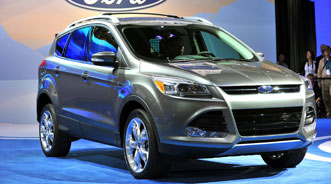Ford to Remedy ETB Issue Without Official Recall

The 2013 Ford Escape was among the 1.6 million units investigated by the National Highway Traffic Safety Adminstration stemming from allegations of electronic throttle body (ETB) failures resulting in sudden reduction of engine power.
Earlier this week, the National Highway Traffic Safety Administration closed a nearly year-long preliminary evaluation to investigate allegations of electronic throttle body (ETB) failures resulting in sudden reduction of engine power in four different models: the Ford Escape and Fusion and Mercury Mariner and Milan.
During this investigation of nearly 1.6 million units from the 2009 through 2013 model years, the Office of Defects Investigations determined Ford identified a condition in subject vehicles equipped with 2.5-liter and 3.0-liter engines.
According to Ford, the ETB internal motor contacts may develop a high resistance material buildup condition on the commutator, resulting in intermittent electrical connectivity and reduced engine power.
“When this condition occurs, the Malfunction Indicator Lamp (MIL) or Wrench light will illuminate and the vehicle may enter a limited limp home mode,” federal officials said. “In this mode, engine power and vehicle speed are reduced, while full function of the power steering, power braking, lighting, and climate control systems are maintained.
“ODI’s complaint analysis indicate that the predominant failure mode involved reduced motive power associated with the limited limp home mode with engine speeds limited to approximately 900 RPM,” they continued.
NHTSA decided not to ask for an official recall, but the agency indicated Ford developed a remedy procedure and issued a special customer satisfaction program extending the ETB warranty coverage and instructing franchised dealers to update the powertrain calibration to improve vehicle performance in the event that intermittent electrical connectivity of the throttle body motor contacts occurs
“Ford is committed to providing our customers with top quality vehicles. We are equally committed to addressing potential issues and responding quickly for our customers,” Ford spokesperson Kelli Felker said in a message to Auto Remarketing on Tuesday.
“If customers are having an issue, dealers will replace the throttle bodies at no cost to the customer,” Felker continued. “They will also update the powertrain control module software to improve vehicle performance in the instance that the electronic throttle body does develop intermittent electronic connectivity.
“Customers will also receive a one-time extended warranty on the electronic throttle body for a total of 10 years or 150,000 miles from the warranty start date, whichever occurs first,” she went on to say.
The Blue Oval first sent a bulletin to dealers on Jan. 17 and notices to owners first started to be sent on Jan. 27, according to NHTSA.
While federal officials said this preliminary evaluation is closed, they added: “The closing of this investigation does not constitute a finding that a safety-related defect does not exist.”

 View The Latest Edition
View The Latest Edition

